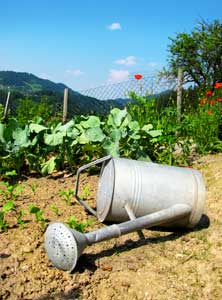Blog Action Day is an annual event that unites the world’s bloggers in posting about the same issue on the same day. Blog Action Day 2025 focuses on the issue of water.
We have all become familiar with the concept of the carbon footprint: the amount of carbon dioxide emitted by any particular person, group, or product. The idea of the water footprint is a similar measure of water consumption: the number of gallons (or liters) used by a person or product. Although the method of calculating and standardizing the measuring of water footprints is being debated, it is currently most commonly expressed as a simple sum of the volume used during a product’s production.
Like fossil fuel, fresh water is a limited resource and its improper consumption leads to waste and pollution. Although water is usually replenished by natural cycles, population expansion in arid regions and water-intensive production are threatening to diminish water reserves. That’s why professor Arjen Hoekstra developed the water footprinting concept, to highlight the role water plays in production chain.
How much water is really embedded in our food? Here’s a sample, provided by treehugger.com:
- 1 cup of coffee = 29 gallons
- 1 cup of tea = 7 gallons
- 1 glass of wine = 58 gallons
- 1 pound of eggs = 573 gallons
- 1 pound of pork = 1630 gallons
- 1 pound of butter = 2044 gallons
- 1 pound of rice = 403 gallons
- 1 pound of potatoes = 30 gallons
- 1 pound of apples = 83 gallons
- 1 pound of tomatoes = 22 gallons
 Regional differences can make a huge difference, and is a major point of contention among researchers. The numbers above represent global averages, not the specific conditions of any one place. Further, some argue that not all water sources should be treated equally. For example, although peanuts require as much as 368 gallons of water per pound, they are typically grown in regions where rain water is abundant and irrigation is not required. Tomatoes, on the other hand, can require elaborate irrigation systems that may deplete ground water sources. A pound of beef requires 2500 gallons of water in some regions, but as much as 5000 gallons in others.
Regional differences can make a huge difference, and is a major point of contention among researchers. The numbers above represent global averages, not the specific conditions of any one place. Further, some argue that not all water sources should be treated equally. For example, although peanuts require as much as 368 gallons of water per pound, they are typically grown in regions where rain water is abundant and irrigation is not required. Tomatoes, on the other hand, can require elaborate irrigation systems that may deplete ground water sources. A pound of beef requires 2500 gallons of water in some regions, but as much as 5000 gallons in others.
What You Can Do
While water footprinting may find more applications for water conservation in industry and agriculture, there are still ways that individual consumers can reduce their water footprint. There’s also good news: many of these measures are also good for your health and the environment in other ways.
One of the best ways to cut down your water footprint is to get the majority of your calories from fruits and vegetables. This is also one of the best things you can do for your health and can help aid in weight loss. Cutting down on processed and individually packaged foods will reduce your water footprint, plus cut down on landfill and chemical pollutants. Finally, reducing your meat consumption is the fastest way to lower your carbon footprint.
Sources: Scientific American and Waterfootprint.org.
Also Read:
